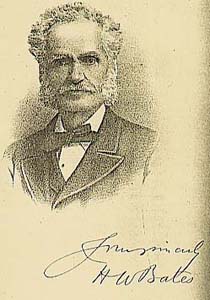
HENRY WALTER
BATES
|
|
Henry Bates is famous
for his contributions to the taxonomy of Neotropical scarabs,
among other things. He and Alfred Russel Wallace left England
in 1842 to explore and collect insects in the Amazon basin in
what was to become incredibly valuable explorations and insights
into natural history and evolution for the both of them. Bates
spent 11 years in Amazonia amassing large collections of insects
that were sent back to museums and collectors in Europe. Bates
was quick to embrace Darwin's and Wallace's theory of evolution
by natural selection. Bates' own theory of mimicry, which now
bears his name (Batesian mimicry), provided evidence for evolution
by natural selection. For several years after his Amazon travels,
Bates worked mostly on butterflies. When he obtained his position
with the Royal Geographical Society, he sold his Lepidoptera
to Godman and Salvin and then began to work mostly on cerambycids,
carabids, and cicindelids. Bates assumed the post of Assistant
Secretary of the Royal Geographical Society in 1864 and continued
in this position for 28 years until his death. Scarabaeoids
were not really his taxonomic specialty, and yet he described
over 700 of them as new to science. Foremost among these publications
(at least for scarab workers) was the lamellicorn volume of
the Biologia Centrali-Americana, a series that he helped
to plan. Bates described 494 species of Neotropical scarabs
in the Biologia. Bates began to work on scarabs fairly
late in his career. His first "fully scarab" paper
was published in 1868. In fact, only three papers (plus the
Biologia volume) were devoted exclusively to scarabs.
His other scarab descriptions were part of other papers in which
he dealt with other families of beetles.
In his introduction to the scarab
volume of the Biologia, Bates stated that "the genera
representing the Scarabaeoidea were placed by Linnaeus and other
early systematists (apparently under a vague, but no less true,
sense of their superior organization) at the head of the whole
coleopterous series." Henry may have like carabids and
longhorn beetles greatly, but he knew the true worth of scarabs!
Reference:
O'Hara, J.E. 1995. Henry Walter
Bates---his life and contributions to biology. Archives of Natural
History 22: 195-219. |